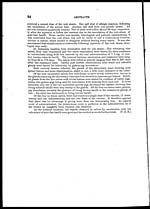Medicine - Veterinary > Veterinary colleges and laboratories > Indian journal of veterinary science and animal husbandry > Volume 12, 1942 > Original articles > Abstracts
(99) Page 83
Download files
Individual page:
Thumbnail gallery: Grid view | List view

ABSTRACTS 83
Derris infusion as a poultry dip for louse eradication. GAPUZ, B. RUFINO
(1940). Philipp. J. Anim. Indus., 7, 153-159.
INFUSIONS of crushed fresh roots of Derris philippinensis proved effective against
lice (Menopon spp. and Lipeurus spp.) infesting White Leghorns and Rhode Island Reds
in the Philippines. The roots were crushed with a hammer and steeped in water in the
proportion of 1 : 20 for 2 or 3 days and the 5 per cent solution thus obtained killed the
lice in 6 hours, whilst concentrations of 2 and 1 per cent killed them in 12 and 24 hours
respectively. The 5 per cent solution retained its killing power for 7 days, but it had
practically no effect on the lice after 14 days. The fresh infusion, when used in any of
the three concentrations mentioned above, destroyed also the eggs, as was evidenced by
the fact that no nymphs or adults were encountered on treated birds that had been
confined in individual cages for 5 weeks, which, in the case of chicken lice, represents
the period from the egg to the adult stage. In another series of experiments, crushed
derris roots, that had been dried for 2½ months in shade, were steeped in water and the
killing power of the infusion thus obtained was tested in concentrations of 1, 0.5 and 0.25
per cent; only the first two of these concentrations proved lethal for adult lice. An
infusion of crushed fresh stems of D. philippinensis, when used in a concentration of 20
per cent, was found to be ineffective. In all the trials, the infusions were used in the form
of dips, the latter having been slightly warmed to facilitate thorough drenching. In the
Philippines, the best time for dipping birds was found to be 10 o'clock in the morning.
[S. K. S.]
Inoculation and immunity experiments on calves with the vole strain of acid-
fast bacilli. A. S. GRIFFITH and T. DALLING (1940). J. Hyg. 40, 673.
SINCE Wells [1937] reported the occurrance of tuberculosis among wild voles, new possi-
bilities of attack of the problem of tuberculosis opened up. The vole acid fast bacilli
is not virulent for the guinea-pig when administered in small doses intraperitoneally
or in large doses subcutaneously. In this paper, the authors have tried to explore the
possibility of using the vole strain as an immunizing agent against tuberculosis.
Experiments with guinea-pigs
(1) Ten guinea-pigs received subcutaneously nine weekly doses (eight of one mg.
and the ninth of 2 mg.) of the vole strain of acid-fast bacilli. Four weeks after the ad-
ministration of the last dose the treated animals along with five controls were injected
subcutaneously with 0.001 mg. of virulent bovine bacilli. The controls died of generalized
tuberculosis in from 67 to 111 days averaging 87 days. The treated guinea-pigs died in
from 109 to 225 days, averaging 152 days, showing lesions typical of infection with viru-
lent tubercle bacilli.
The effect of the Vaccine was simply to delay the development of tuberculosis.
(2) In the second experiment eight guinea-pigs received subcutaneously seven weekly
injections (two each of one mg. and five each of 2 mg.). One day after the last dose
these guinea-pigs were tested along with four controls by the subcutaneous inoculation
of 0.01 mg. of bovine bacilli. The controls died of generalized tuberculosis in from 51
to 93 days. The vaccinated guinea-pigs killed 94 and 95 days after the test dose, showed
less advanced lesions.
Experiments with calves
It is essential to note that calves for these experiments were obtained from the
tuberculosis-free herd maintained at the Agricultural Research Council's Field Station
at Compton.
(1) Effect of inoculating calves with the vole strain of acid-fast bacilli. Thirteen calves
were inoculated, one intra-muscularly, some intra-venously and others subcutaneously
with the vole strain. The intra-muscular dose was 80 mg., the intravenous dose ranged
from 0.01 to 10 mg. and the subcutaneous dose ranged from 20 to 75 mg. Six of these
Set display mode to: Large image | Zoom image | Transcription
Images and transcriptions on this page, including medium image downloads, may be used under the Creative Commons Attribution 4.0 International Licence unless otherwise stated. ![]()
| Permanent URL | https://digital.nls.uk/75259382 |
|---|
| Description | Covers articles from 1942. |
|---|




